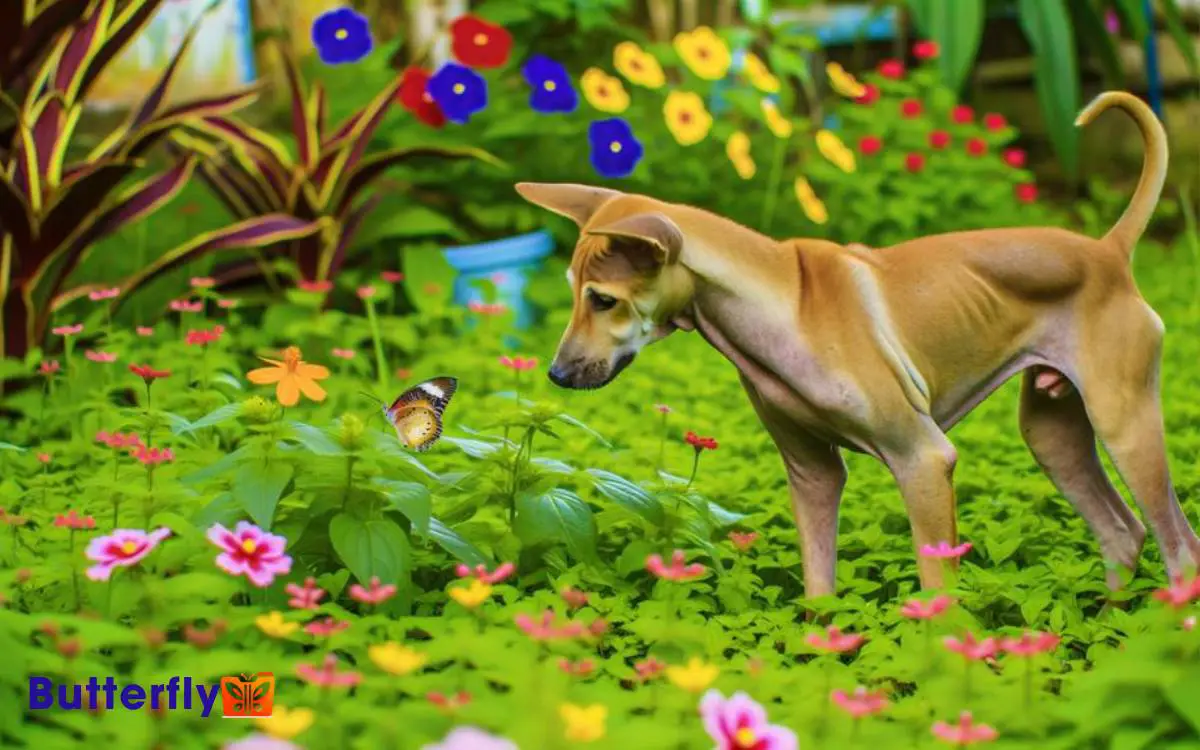Are Butterflies Poisonous to Dogs? Risks and Precautions!
Some butterfly species are poisonous to dogs. Monarch butterflies contain cardiac glycosides, which can cause vomiting, diarrhea, and lethargy in dogs. Pipevine Swallowtails have toxic alkaloids that also pose a risk.
Other butterflies like Red Admirals and Cabbage Whites are less harmful. Symptoms of poisoning include drooling, tremors, and difficulty breathing, requiring immediate veterinary attention.
Safe species include Eastern Tiger Swallowtails and Painted Ladies. Identifying toxic butterflies and knowing the symptoms helps you protect your dog. There’s more to learn about preventing butterfly ingestion and what steps to take if your dog encounters a toxic butterfly.

Key Takeaways
Common Butterfly Species
Among the common butterfly species you might encounter, Monarchs, Swallowtails, and Painted Ladies are some of the most recognizable.
- Monarchs are famed for their striking orange and black wings, and they migrate thousands of miles.
- Swallowtails are notable for their large size and distinctive tail-like extensions on their hindwings.
- Painted Ladies, on the other hand, exhibit a unique orange and brown pattern with white spots.
Understanding these species is essential if you want to identify them accurately. Each species has specific habits and habitats, which can help you predict where and when you might see them.
Being able to recognize these butterflies will aid in further understanding their interactions with the environment and potential impacts on your dog.
Butterfly Toxins
While butterflies are often admired for their beauty, some species possess toxins that can pose risks to dogs. Monarch butterflies, for example, contain cardiac glycosides acquired from the milkweed plants they consume as larvae. These compounds can be harmful if ingested by dogs.
Similarly, the Pipevine Swallowtail harbors aristolochic acids, which are toxic alkaloids obtained from pipevine plants.
You should also be aware that the toxins aren’t just present in the adult butterflies but can be found throughout their life stages, including caterpillars and pupae.
Even though the importance levels vary, it’s essential to recognize that ingestion of these butterflies can lead to adverse effects in dogs.
Potential Risks to Dogs
Understanding the potential risks to dogs from ingesting butterflies is essential for every pet owner. Butterflies can contain toxins that may pose a danger to your dog.
The severity of the risk varies depending on the butterfly species, the amount ingested, and your dog’s size and health.
| Butterfly Species | Toxin Type | Risk Level |
|---|---|---|
| Monarch | Cardiac glycosides | High |
| Pipevine Swallowtail | Aristolochic acid | Moderate |
| Red Admiral | Unknown | Low |
| Cabbage White | None | None |
Symptoms of Poisoning
Recognizing symptoms of poisoning in your dog after it ingests a butterfly can help you take immediate action to guarantee its safety. Look for signs such as vomiting, diarrhea, drooling, and lethargy. These symptoms might indicate your dog has ingested a toxic butterfly.
Tremors, seizures, or difficulty breathing are more critical symptoms and require immediate veterinary attention.
Don’t overlook behavioral changes like excessive licking or pawing at the mouth, which can also signal poisoning. Early detection is essential, so keep an eye on your dog’s condition following butterfly consumption.
If you notice any of these symptoms, contact your veterinarian immediately. Prompt intervention can prevent further complications and safeguard your dog’s well-being.
Safe Butterfly Species
Not all butterflies pose a risk to your dog, and knowing which species are safe can help you prevent unnecessary worry.
Most native butterflies, like the Eastern Tiger Swallowtail and the Common Buckeye, are generally harmless. These species don’t contain toxic compounds that could harm your pet if ingested.
Monarch butterflies, however, are an exception and should be avoided. Their larvae feed on milkweed, making them toxic. Additionally, Painted Ladies and Mourning Cloaks are also safe, as they don’t accumulate harmful substances.
First Aid for Dogs
Should your dog come into contact with a potentially harmful butterfly, knowing basic first aid measures can help mitigate adverse effects.
First, remain calm and assess your dog’s condition. Look for signs like drooling, vomiting, or lethargy. If symptoms are present, contact your veterinarian immediately. Meanwhile, you can rinse your dog’s mouth with water to remove any harmful residues.
| Symptom | Immediate Action |
|---|---|
| Drooling | Rinse mouth with water |
| Vomiting | Withhold food, give water |
| Lethargy | Keep dog calm, call vet |
| Diarrhea | Monitor, keep hydrated |
| Swelling | Apply cold compress, vet |
Keep the veterinarian’s contact information handy and make sure your dog is comfortable. Quick action can be vital for your pet’s health.
Preventing Butterfly Ingestion
To safeguard your dog from ingesting butterflies, make sure they’re supervised during outdoor activities and keep them away from areas with high butterfly populations.
Ensuring your dog’s safety requires proactive measures:
- Supervision: Always watch your dog closely when they’re outside, especially during peak butterfly seasons.
- Training: Teach your dog basic commands like ‘leave it’ to prevent them from chasing or eating butterflies.
- Environment Control: Avoid walking your dog in areas known for high butterfly activity, such as gardens or meadows.
- Outdoor Gear: Use a leash and harness to maintain control and quickly redirect your dog’s attention if they show interest in butterflies.
Implementing these steps will help minimize the risk of butterfly ingestion.
Veterinary Guidance
Consulting with a veterinarian is crucial if you suspect your dog has ingested a butterfly, as they can provide professional advice and treatment options.
The veterinarian will assess your dog’s symptoms, which may include vomiting, diarrhea, or lethargy, and determine the best course of action. They may conduct a physical examination and possibly suggest diagnostic tests to rule out any toxins or parasites that butterflies might carry.
Immediate veterinary attention guarantees that any potential adverse effects are promptly managed, minimizing health risks.
Don’t attempt home remedies or wait for symptoms to worsen; early intervention is key. Your vet’s guidance will help ensure your dog’s safety and well-being, providing peace of mind during such incidents.
Conclusion
Just as Persephone’s pomegranate seeds had unforeseen consequences, your dog ingesting certain butterflies can lead to unexpected health issues.
While not all butterflies pose a threat, it’s important to recognize the symptoms of poisoning and take swift action. Always consult your vet if you suspect any ingestion. Some butterflies contain toxic compounds that can be harmful if consumed by pets, leading to symptoms like vomiting, drooling, or lethargy. Although rare, some people wonder whether butterflies bite or sting, but most species are harmless and do not pose a direct physical threat. However, it’s essential to monitor your pet closely and prevent them from ingesting any unfamiliar insects.
By understanding the potential risks and taking preventative measures, you can guarantee your furry friend enjoys a safe, butterfly-filled environment without any hidden dangers.






